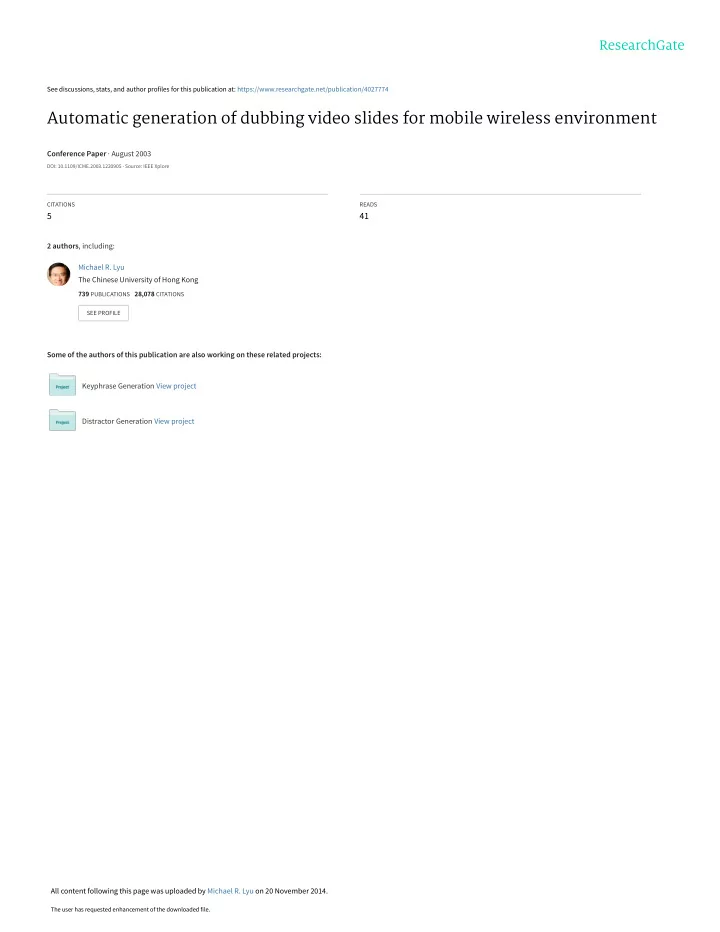

See discussions, stats, and author profiles for this publication at: https://www.researchgate.net/publication/4027774 Automatic generation of dubbing video slides for mobile wireless environment Conference Paper · August 2003 DOI: 10.1109/ICME.2003.1220905 · Source: IEEE Xplore CITATIONS READS 5 41 2 authors , including: Michael R. Lyu The Chinese University of Hong Kong 739 PUBLICATIONS 28,078 CITATIONS SEE PROFILE Some of the authors of this publication are also working on these related projects: Keyphrase Generation View project Distractor Generation View project All content following this page was uploaded by Michael R. Lyu on 20 November 2014. The user has requested enhancement of the downloaded file.
AUTOMATIC GENERATION OF DUBBING VIDEO SLIDES FOR MOBILE WIRELESS ENVIRONMENT Wei Wang and Michael R. Lyu Dept. of Computer Science & Engineering The Chinese University of Hong Kong Email: {weiwang@nudt.edu.cn, lyu@cse.cuhk.edu.hk } ABSTRACT providing video service at present. It would be better to discard those unimportant frames selectively rather than Mobile wireless video delivery is still challenging due to dropping frames passively and randomly during delivery. its limited bandwidth and dynamic channel status. In this Therefore, video summary [3][4] becomes an attractive paper, a novel approach named Dubbing Video Slides approach for the current mobile wireless video services. (DVS) is proposed to cope with the bandwidth limitation Existing solutions mainly focus on video skimming and problem. Based on a statistical video content importance static video storyboard [5], which were designed to help analysis, DVS method can dynamically select and rapid browsing for locating what users want in a large transmit representative video frames which are relatively video database. Static storyboard just provides visual more important, and discard others according to current outline without providing the audio information. Video network status feedback. To save bandwidth, we can use skimming is composed of most brilliant clips without these representative frames as substitutes for those involving the whole video. Given specific videos, both of adjacent video intervals and synchronize with the original them produce fixed summaries. In our context, however, a audio track during playback. The visual simulation shows new scheme is needed which should both include audio- DVS works well for video summary in mobile network visual information and reflect the outline of the whole delivery. video. Furthermore, it should be able to produce summaries in different granularity according to the 1. INTRODUCTION dynamic variety of network bandwidth. This sets forth to the design and implementation of our video summary scheme. With the rapid development of mobile wireless network and popularization of wireless terminals, versatile mobile Video frame time service requirements also increased rapidly. Among them, video delivery is the most important one. As a major Audio track objective pursued by the communications manufacturers, (a)original video and audio track video delivery via mobile wireless network faces diverse Video frame time challenges[1][2], including limited bandwidth, dynamic Audio track network conditions with low stability, variety of relay (b)Non uniform samples based on video content equipment, different terminal decoding speeds, various Figure1: Original Video and DVS display screen resolution and color depth, confliction between high power consumption, and limited battery 2. Dubbing Video Slides (DVS) Scheme capacity, etc. Research work aiming at these challenges has been conducted recently and some achievements have We describe an innovative summary scheme named been made including more efficient transmission Dubbing Video Slides (DVS) for mobile wireless video protocols across different network layers, open interface delivery, which can leverage dynamically between standards to the Internet backbone, more efficient data bandwidth and video quality. As shown in Figure 1, via compression encoding and decoding, better transmission DVS we can select and transmit dynamic amounts of control, improved error correction, adaptive QoS control, representative video frames which are deemed more and efficient power control, etc. important and discard others, based on a statistical video Even with all these improvements, video delivery content importance analysis. We then use these based on MPEG4 and RTSP cannot satisfy the actual representative frames as substitutes for those adjacent requirement yet. Restricted wireless bandwidth is a video intervals, and synchronize them with the original dominating factor. Compromise must be made when audio track during playback. As long as the discarding of
Recommend
More recommend